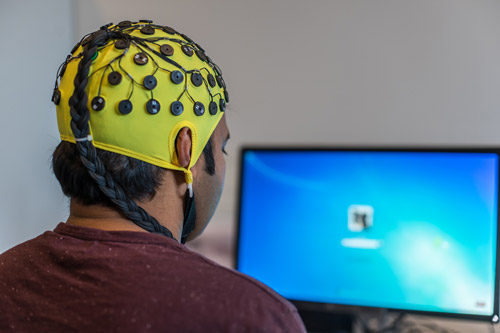What is Cranial Electrotherapy Stimulation (CES)?
Cranial Electrotherapy Stimulation (CES) is a non-invasive method of delivering a small electrical current to the brain through electrodes placed on the scalp. It is used as a treatment for anxiety, depression, insomnia, and other conditions.
The mechanism is said to amplify some neurological system activity and deactivate others in a fine-tuning process called neuro-modulation.
The process affects neurotransmitters in the brain and alters patterns of neural activity. It is considered a safe and well-tolerated treatment, but more research is needed to determine its effectiveness for specific conditions.
The exact way that CES affects neurotransmitters is not known, but it is thought to increase the levels of serotonin and endorphins, which are neurotransmitters involved in regulating mood, sleep, and pain. It is also thought to increase levels of melatonin, a hormone that regulates sleep.
CES is also believed to have an effect on the hypothalamic-pituitary-adrenal (HPA) axis, which is a system in the body that controls the release of stress hormones. By reducing the activity of the HPA axis, CES may help to reduce symptoms of anxiety and depression.

Cranial electrotherapy stimulation is a neuro-modulation tool used for treating clinical disorders
Who Invented Cranial Electrotherapy Stimulation?
Cranial Electrotherapy Stimulation (CES) has been in use for over a century. The first reports of its use date back to the late 19th century, when doctors used it to treat various neurological conditions. In the 1950s and 1960s, CES devices were developed specifically for use in psychiatry and psychology. The technology has evolved over the years to become more portable and user-friendly.
One of the pioneers in the development of CES technology was Dr. Daniel Kirsch, a neurobiologist. He introduced the Alpha-Stim device to the market in 1981, which is still used today for the treatment of anxiety, depression, insomnia, and other conditions.
There were many other researchers and inventors who contributed to the development of CES technology, and it's a field that has been studied and developed by many scientists and doctors over the past century.
In the 1970s and 1980s, CES was used primarily to treat anxiety and depression. However, its use for these conditions waned. In the 1990s, renewed interest in the treatment led to more research being conducted, and CES began to be used for a variety of other conditions such as insomnia, addiction, and chronic pain.
In recent years, CES has been used as an alternative treatment for anxiety and depression, and has been found to be effective in treating these conditions in some cases. However, more research is needed to fully understand the mechanism of action and to determine the optimal parameters for its use.
How Does a Cranial Electrotherapy Stimulation Machine Work?
CES devices are usually small, portable, and easy to use.
Cranial electrotherapy stimulation (CES) involves delivering low-intensity (50 μA to 4 mA) electrical current via a pair of electrodes attached to bilateral anatomical positions around the head (e.g., eyelids, earlobes, mastoids, temples), with the intent of acutely modulating central and/or peripheral nervous system activity (1).
A typical session will last for a period of 20 to 60 minutes. The exact parameters for treatment will depend on the individual and the condition being treated.
What Conditions Can CES Help With?
Cranial Electrotherapy Stimulation (CES) has been studied for a variety of clinical applications, including:
- Anxiety and depression
- Insomnia
- Chronic pain
- Addiction
- Post-traumatic stress disorder (PTSD)
- Migraines and headaches
Are There Any Side Effects with Cranial Electrotherapy Stimulation?
Cranial Electrotherapy Stimulation (CES) is generally considered safe and well-tolerated, with the most common side effects reported being mild and temporary. Some of the possible side effects of CES include:
- Headaches: Some individuals may experience headaches after using CES.
- Drowsiness or fatigue: CES may cause drowsiness or fatigue in some individuals, especially if used at higher intensities or for longer periods of time.
- Tingling or discomfort: Some individuals may experience a tingling or discomfort sensation at the electrode site.
- Insomnia: In some cases, CES may cause insomnia rather than improving it.
- Seizures: In rare cases, CES may cause seizures in individuals with a history of seizures or other neurological conditions.
It's important to note that the risk of serious side effects from CES is considered to be low. However, I recommend that you consult with your healthcare professional before using CES or any other treatment.
What Scientific Evidence is There for Cranial Electrotherapy Stimulation?
The evidence for Cranial Electrotherapy Stimulation (CES) is mixed. Some studies have found that CES is effective in reducing symptoms of anxiety and depression, improving sleep, and reducing pain, while other studies have found no significant benefit.
- In terms of anxiety and depression, CES has been found to be effective in reducing symptoms in some studies.
- In regards to insomnia, CES has been found to improve sleep quality and reduce the time it takes to fall asleep in some individuals.
- In terms of chronic pain, CES has been found to reduce pain in some individuals with chronic pain conditions such as fibromyalgia and neuropathic pain.
- In regards to addiction, CES has been found to reduce cravings and improve outcomes in some individuals with addiction to substances such as opioids and alcohol.
- In terms of PTSD, Migraines, and headaches the evidence is limited and inconclusive.
In all cases more research is needed to fully understand its effectiveness and to determine the optimal parameters for its use.
Are CES Devices FDA Approved?
The FDA has classified CES devices marketed to treat anxiety or insomnia as Class II medical devices. Class II products are considered moderate risk. Such devices have sustained contact with a patient, and general controls are not sufficient for ensuring device safety or efficacy; examples include syringes and contact lenses.
Where Can I Buy a CES Machine?
About a dozen devices are currently available for consumer purchase in the United States, varying in price from $300–5,000USD.
According to regulation, devices can only be ordered by licensed medical practitioners, or by patients who complete a low-cost telemedicine visit.
Here is a list of companies that sell CES machines:



Leave a Reply